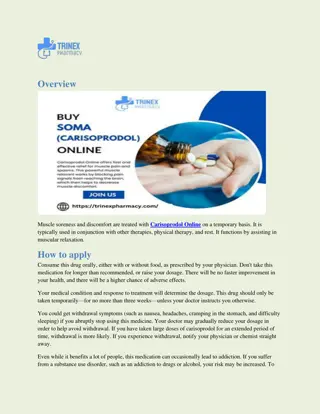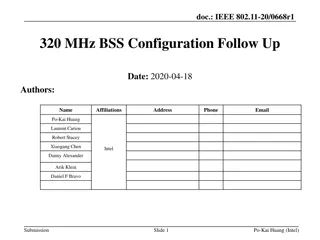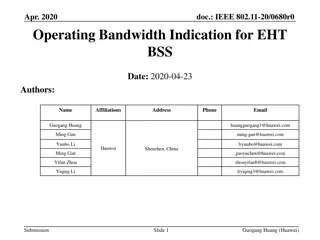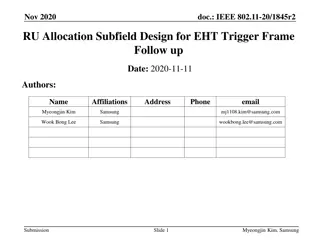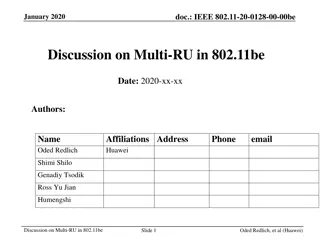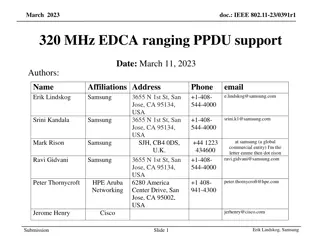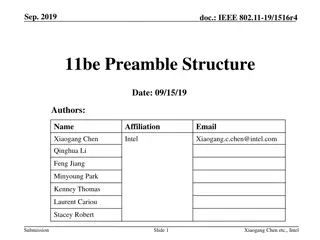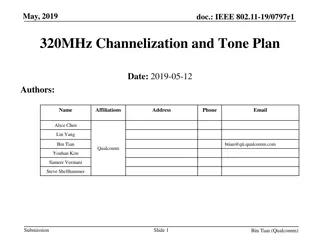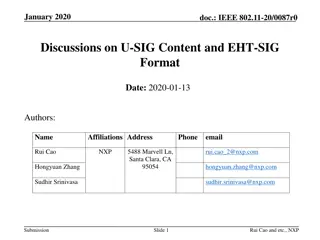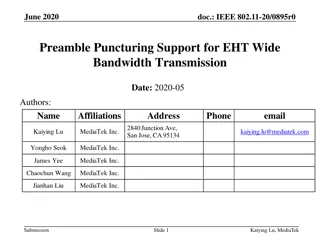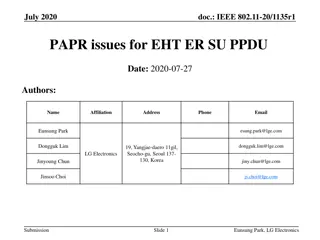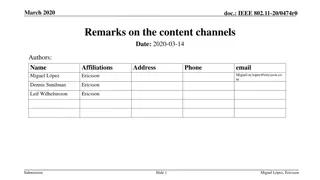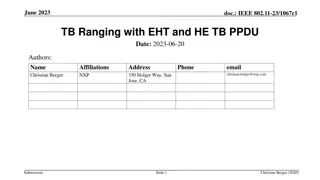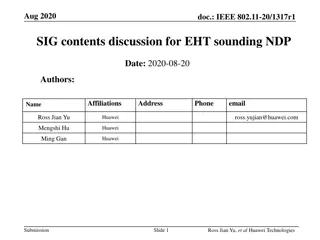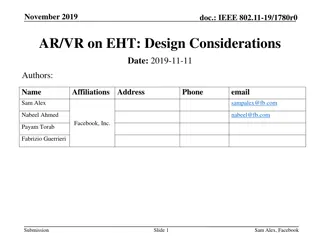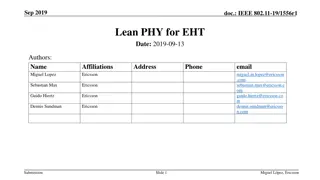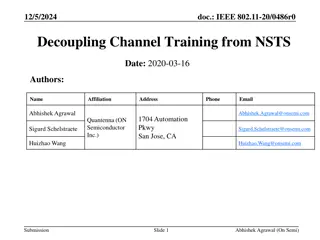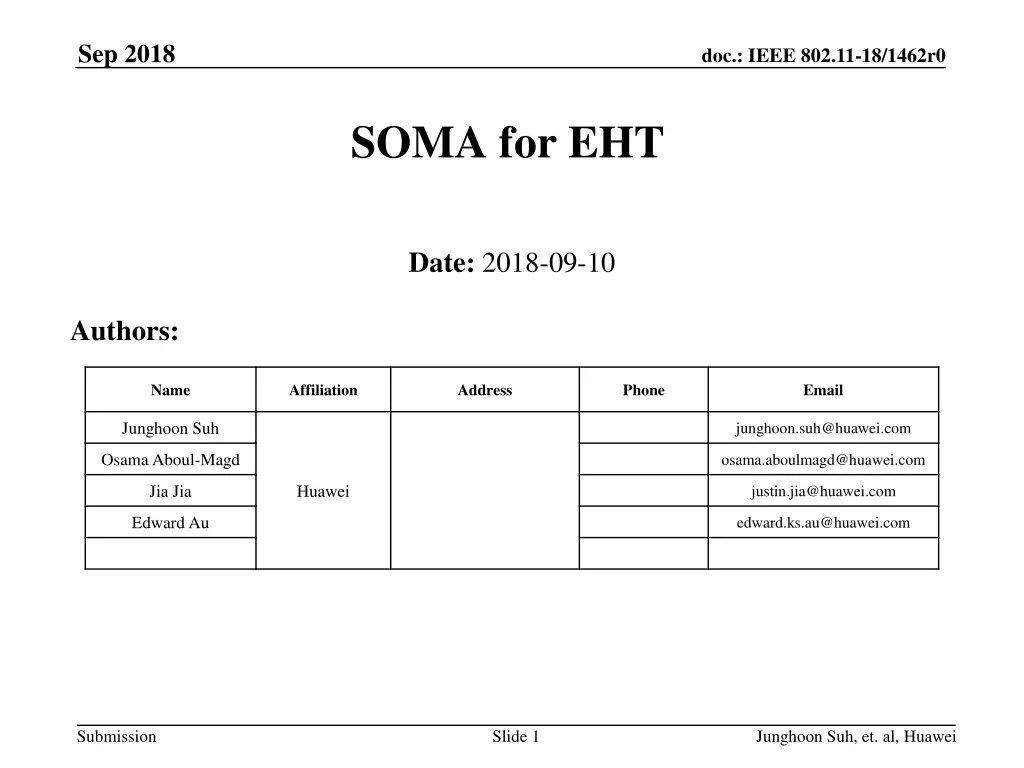
IEEE 802.11-18/1462r0 SOMA for Extreme High Throughput Study Group
Explore the proposal of Semi-Orthogonal Multiple Access (SOMA) for improving the efficiency of IEEE 802.11 in the Extreme High Throughput (EHT) domain. This technology aims to increase peak throughput and enhance efficiency to support high-demand applications like video-over-WLAN, gaming, AR, and VR by utilizing superposition transmission with adaptive power ratios on component constellations. SOMA, a proven concept in 3GPP LTE Advanced technologies, offers promising gains in both link and system levels without complex interference cancellation requirements.
Uploaded on | 2 Views
Download Presentation

Please find below an Image/Link to download the presentation.
The content on the website is provided AS IS for your information and personal use only. It may not be sold, licensed, or shared on other websites without obtaining consent from the author. If you encounter any issues during the download, it is possible that the publisher has removed the file from their server.
You are allowed to download the files provided on this website for personal or commercial use, subject to the condition that they are used lawfully. All files are the property of their respective owners.
The content on the website is provided AS IS for your information and personal use only. It may not be sold, licensed, or shared on other websites without obtaining consent from the author.
E N D
Presentation Transcript
Sep 2018 doc.: IEEE 802.11-18/1462r0 SOMA for EHT Date: 2018-09-10 Authors: Name Affiliation Address Phone Email Junghoon Suh junghoon.suh@huawei.com Osama Aboul-Magd osama.aboulmagd@huawei.com Jia Jia Huawei justin.jia@huawei.com Edward Au edward.ks.au@huawei.com Submission Slide 1 Junghoon Suh, et. al, Huawei
Sep 2018 doc.: IEEE 802.11-18/1462r0 Background EHT SG is approved [1] Approve formation of an EHT SG (Extreme High Throughput Study Group) to develop a Project Authorization Request (PAR) and a Criteria for Standards Development (CSD) for a new 802.11 amendment for operating in the bands between 1 to 7.125 GHz, with the primary objectives: To increase peak throughput and improve efficiency To support high throughput and low latency applications such as video-over-WLAN, gaming, AR and VR With target start of the task group in May 2019 We propose Semi Orthogonal Multiple Access (SOMA) to improve the efficiency of 802.11 Submission Slide 2 Junghoon Suh, et. al, Huawei
Sep 2018 doc.: IEEE 802.11-18/1462r0 SOMA Semi-Orthogonal Multiple Access Superposition transmission with adaptive power ratio on component constellations and Gray-mapped superposed constellation It is not just a superposition of multiple component constellations, but artificially designed to make the superposed constellation to be gray-mapped so that the Interference Cancellation doesn t have to be necessary at the Near STA Receiver is less complex Little changes to the current 802.11 Transceivers Data come from multiple STAs to form a constellation in the TX side Only the LLRs corresponding to the receiver will be retrieved in the STA side Technology is mature SOMA is a part of 3GPP LTE Advanced technologies Multi-User Superposition Transmission (MUST) in Section 6.3.3 of TS 36.211 The gain is already proven in both Link and System Level SOMA was first presented in IEEE 802.11 WNG SC, July 2016 16/943r0 Introduction to SOMA Submission Slide 3 Junghoon Suh, et. al, Huawei
Sep 2018 doc.: IEEE 802.11-18/1462r0 Superposition Transmission = + x P s P s Transmission signals: 1 1 2 2 OMA Superposition P1 BW1=BW/2 Power Power BW2=BW/2 P2 SNR = 0dB Freq Freq BW SNR = 20dB OMA: P1 = P2 = 0.5 , R Superposition: P1 = 0.2, P2 = 0.8 2 N 2 2 P h P h = + = + 1 N 1 2 log 1 log 1 R 1 2 2 2 2 + P h 1 , 0 1 2 2 , 0 OMA 3.33 0.5 Superposition 4.39 (+32%) 0.74 (+48%) R1 (bps/Hz) R2 (bps/Hz) Source: Saito, et al, Non-Orthogonal Multiple Access for Cellular Future R adio Access , VTC, June 2013. Submission Slide 4 Junghoon Suh, et. al, Huawei
Sep 2018 doc.: IEEE 802.11-18/1462r0 Re-cap There are bits more reliable than others in a QAM constellation [2]. The bits more reliable may be scheduled for a STA in lower SNR channel The bits less reliable may be scheduled for a STA in higher SNR channel 4 bits for 16-QAM: i1i2q1q2 where i1i2 are the in- phase components and q1q2 are the quadrature- phase components. Here, i1 and q1 are the most reliable bits and i2 andq2 are the least reliable bits. In the same way, for 6 bits (i1i2i3q1q2q3) of 64- QAM, i1 and q1 are the most reliable bits, i2 and q2 are the medium reliable bits, and i3 andq3 are the most reliable bits. As for 256 QAM (i1i2i3i4q1q2q3q4) , i1 and q1 are the most reliable bits, i2 andq2 are the first medium reliable bits, i3 andq3 are the second medium reliable bits, and i4 andq4 are the least reliable bits. 16 QAM Constellation with Gray-mapping Submission Slide 5 Junghoon Suh, et. al, Huawei
Sep 2018 doc.: IEEE 802.11-18/1462r0 SOMA For STA 1 (Near STA) and STA 2 (Far STA) in the figure beside, the SOMA is not just a superposition of two constellations from two STAs, but, instead, the property of more and less reliable bits in a constellation is used to schedule Far and Near STAs as seen in the figure below For Near-STA to decode Near-STA bits, Far-STA bits need Not to be known The Far-STA decodes its own signal, and treats Near -STA as noise just like a Superposition The Near-STA performs the demodulation of the re- ceived signal, collecting the LLRs corresponding to the near coded bits, and then performs decoding of the near-STA codeword. Complexity in the Receiver side is reduced SOMA can be applied with OFDMA and its throughput enhancement at AP side is significant, compared to the OFDMA only STA2 STA1 Submission Slide 6 Junghoon Suh, et. al, Huawei
Sep 2018 doc.: IEEE 802.11-18/1462r0 TX/RX design flow for Single Stream based SOMA STA 1 FEC Encoder Interleaver SOMA Spatial Mapping To Antenna STA 2 Constellation Mapper IFFT Interleaver FEC Encoder .. .. .. Interleaver STA N FEC Encoder De-inter- leaver STA 1 FEC Decoder LLR Channel Estimation and Equalization De-inter- leaver FFT Computation STA 2 FEC Decoder .. .. . De-inter- leaver STA N FEC Decoder The data of each STA are separately encoded and interleaved, before being combined for the SOMA constellation mapping. The STA 1 through STA N represent the SOMA scheduled STAs. Each STA can take the corresponding LLR information and take the De-interleaving separately, which will be followed by FEC Decoder for each STA to recover its data Slide 7 Submission Junghoon Suh, et. al, Huawei
Sep 2018 doc.: IEEE 802.11-18/1462r0 Simulation for a single stream based SOMA CSMA Near STA1 original link: MCS3 (16QAM,1/2) Far STA2 original link: MCS1 (QPSK, 1/2) SOMA Total Constellation: 16QAM Near STA1 new link: MCS1 (2 less reliable bits of 16QAM, 1/2) Far STA2 new link: MCS1 (2 more reliable bits of 16QAM, 1/2) Submission Slide 8 Junghoon Suh, et. al, Huawei
Sep 2018 doc.: IEEE 802.11-18/1462r0 How to compute the System Goodput STA Goodput IDFT T ( ) ( ) ( ) = 1 Rate SNR PER SNR M R STAi STAi STAi STAi + IDFT T T GI where R is a code rate and M is a bit size per QAM constellation System Goodput for CSMA (without consideration of contention period) = SYS SNR Goodput ( ) STAi T Rate SNR ( ) STAi STAi T System Goodput for SOMA ( ) STAi T Rate max SNR ( ) STAi = Goodput SNR SYS STAi T STAi Submission Slide 9 Junghoon Suh, et. al, Huawei
Sep 2018 doc.: IEEE 802.11-18/1462r0 Performance Comparison-w/ CFO and PN Submission Slide 10 Junghoon Suh, et. al, Huawei
Sep 2018 doc.: IEEE 802.11-18/1462r0 System Goodput Evaluation-w/ CFO and PN Fixed SNR difference between STAs Variable SNR at STA2 Submission Slide 11 Junghoon Suh, et. al, Huawei
Sep 2018 doc.: IEEE 802.11-18/1462r0 System Goodput Evaluation-w/ CFO and PN Fixed SNR at STA2 Variable SNR difference between STAs Submission Slide 12 Junghoon Suh, et. al, Huawei
Sep 2018 doc.: IEEE 802.11-18/1462r0 MIMO based SOMA Submission Slide 13 Junghoon Suh, et. al, Huawei
Sep 2018 doc.: IEEE 802.11-18/1462r0 Simulation for MIMO based SOMA 16-QAM SOMA on top of 4X4 Open-loop SU-MIMO 2 STA SOMA with each STA modulated in QPSK and MMSE MIMO detection 16-QAM SOMA on top of 2X2 Open-loop SU-MIMO 2 STA SOMA with each STA modulated in QPSK and MMSE MIMO detection Baseline performance to compare with 8TX MU-MIMO scheduled with 2 STAs, each STA scheduled with 4 Streams and modulated in QPSK, respectively / 4TX MU-MIMO scheduled with 2 STAs (each 2 streams and in QPSK) Limited sounding error (No CSI Quantization error, No CSI feedback error, but real channel estimation using the LTFs) Zero-forcing BF in the TX, and MMSE detection in each STA 4X4 SU-MIMO in QPSK and MMSE MIMO detection Common simulation parameters Convolutional Encoding and its Viterbi decoding are used as FEC MCW (Multi Codeword), separate FEC is applied to each stream For the system Goodput, the SNR is Far STA s SNR and the 1stSTA s SNR for MU-MIMO Submission Slide 14 Junghoon Suh, et. al, Huawei
Sep 2018 doc.: IEEE 802.11-18/1462r0 BER Performance comparison: 4X4 (2X2) 16QAM MIMO-SOMA vs 4X4 SU-MIMO vs 8TX/4TX 2STA MU-MIMO Submission Slide 15 Junghoon Suh, et. al, Huawei
Sep 2018 doc.: IEEE 802.11-18/1462r0 Goodput Performance comparison: 4X4 (2X2) 16QAM MIMO-SOMA vs 4X4 SU-MIMO vs 8TX/4TX 2STA MU-MIMO Submission Slide 16 Junghoon Suh, et. al, Huawei
Sep 2018 doc.: IEEE 802.11-18/1462r0 Performance Summary: MIMO-SOMA Goodput in the high SNR region for both 8X8 MU-MIMO with 2 STA scheduling and 4X4 16-QAM SOMA are both 6.4 bps/Hz MU-MIMO is achieved under the limited sounding errors (No CSI Quantization error, No CSI feedback error, but real channel estimation using the LTFs) We can see that 16-QAM SOMA is not worse than 8X8 MU-MIMO The number of Spatial streams are 4 streams smaller for 16QAM SOMA than 8X8 MUMIMO and the CSI feedback is not required for SOMA in achieving the similar performance SOMA is not a competing technology against MU-MIMO, but rather, is a complementary technology, especially when the Close Loop MIMO is not available due to the time-variant channel and the available spatial resources are limited in the AP side. Submission Slide 17 Junghoon Suh, et. al, Huawei
Sep 2018 doc.: IEEE 802.11-18/1462r0 Conclusions As we saw from the simulation results, a similar throughput can be achieved with SOMA, consuming less spatial resources and CSI feedback overhead, compared to the MU-MIMO SOMA shows a throughput gain over the CSMA The SOMA technology is mature and relatively simple There is no significant change from the current 802.11 design flow Data come from multiple STAs to form a constellation in the TX side Only the LLRs corresponding to the receiver will be retrieved in the STA side SOMA is a part of 3GPP LTE Advanced technologies Multi-User Superposition Transmission (MUST) in Section 6.3.3 of TS 36.211 The gain is already proven in both Link and System Level Submission Slide 18 Junghoon Suh, et. al, Huawei
Sep 2018 doc.: IEEE 802.11-18/1462r0 Appendix New Constellation for 16-QAM in case an adaptive power needs to be applied to each SOMA STA Goodput performance of the SISO based 16-QAM SOMA with different delta-snr (SNR gap between Far and Near STA) and different alpha (power allocation factor) Submission Slide 19 Junghoon Suh, et. al, Huawei
Sep 2018 doc.: IEEE 802.11-18/1462r0 Adaptive Power Allocation based 16-QAM b b b b 0 1 2 3 K + K f n 1 K = K n f 2 K K f n 1 = K n 2 K K K + K K + K K K f n f n f n f n K f K + K f n K K f n When is 0.2, the constellation becomes the 802.11ac 16-QAM The receiver needs to know the to compute the right LLR Submission Slide 20 Junghoon Suh, et. al, Huawei
Sep 2018 doc.: IEEE 802.11-18/1462r0 Goodput for 16-QAM SISO based SOMA Submission Slide 21 Junghoon Suh, et. al, Huawei
Sep 2018 doc.: IEEE 802.11-18/1462r0 Goodput for 16-QAM SISO based SOMA: Selected Curves Submission Slide 22 Junghoon Suh, et. al, Huawei
Sep 2018 doc.: IEEE 802.11-18/1462r0 References [1] R. Stacey, 18/1059r6 802.11 July 2018 WG Motions , IEEE 802.11 WG, July 2018, San Diego CA, USA [2] Saito, et al, Non-Orthogonal Multiple Access (NOMA) for Cellular Future Radio Access , VTC, June 2013 Submission Slide 23 Junghoon Suh, et. al, Huawei
Sep 2018 doc.: IEEE 802.11-18/1462r0 SP Would you be willing to work on the SOMA during the EHT? Y/N/Abs Submission Slide 24 Junghoon Suh, et. al, Huawei

